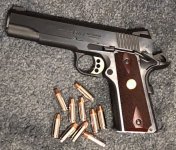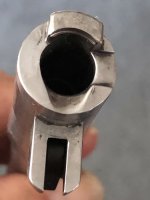stagpanther
New member
I'm not much of a handgun guy, mostly cause my bad eyes have a hard time with their sights (I've been down the road of all kinds of corrective glasses etc.). But I recently stumbled on a goldmine of hand-load recipes on Shooting Times and that has inspired me to dust off my Colt competition series Government in 38 super and try out some new stuff. Its stock irons are big and clear enough that I have less trouble with them than most other handgun irons. Here's my first "at bat" load, .356" 125 Hornady HAPs driven by power pistol in starline nickle-plated brass.



